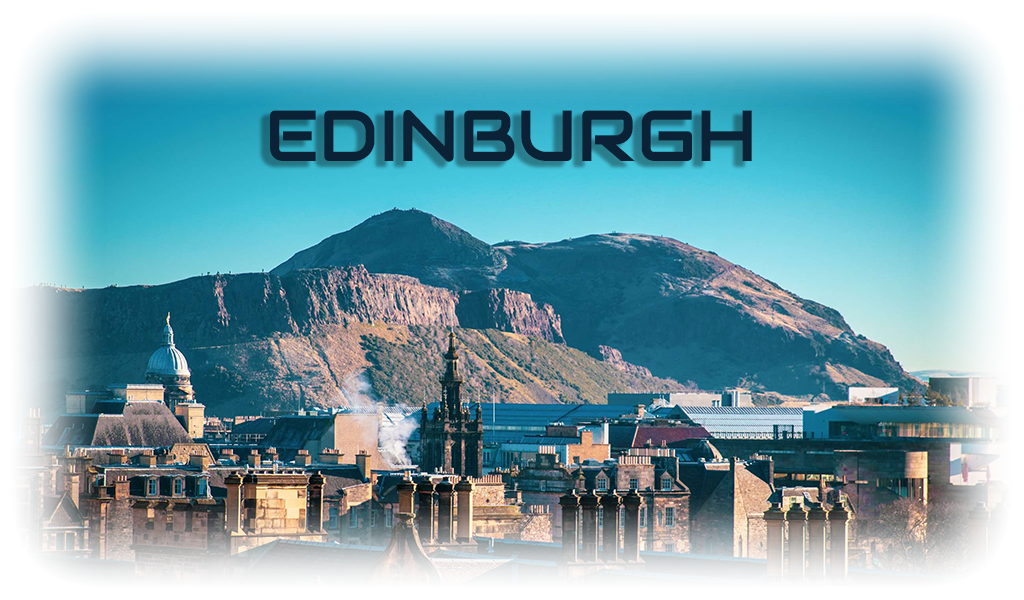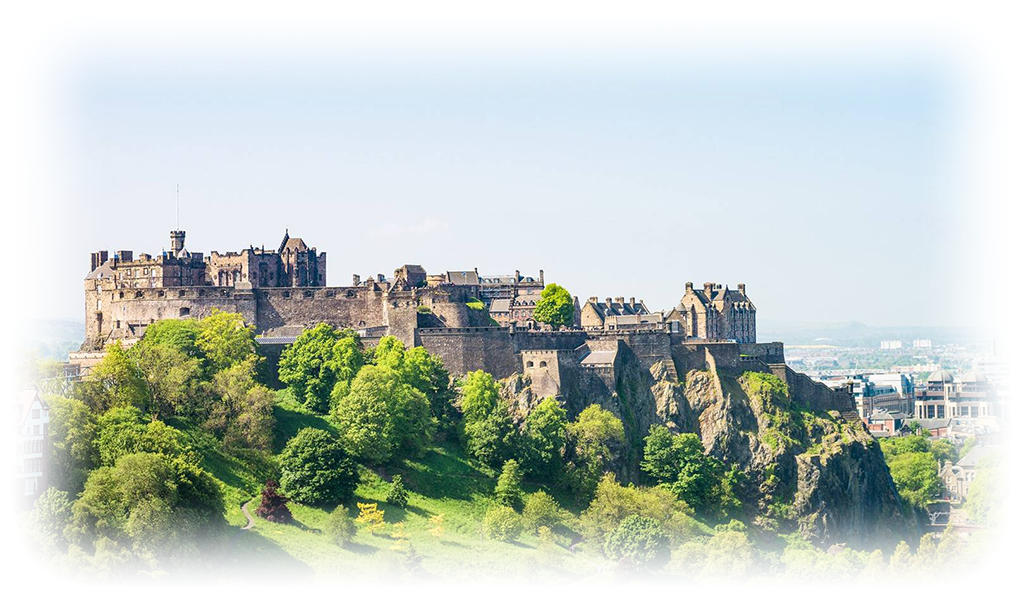
Edinburgh is a Scotland's capital and one of the largest cities in northern Britain. It is a place that combines antiquity and modernity in a unique Scottish atmosphere. Edinburgh is one of the most beautiful cities in the United Kingdom with a large medieval castle, soaring above it on a high rocky peak, and amazing medieval Gothic architecture, which is adjacent to the magnificent examples of modern construction. It is a true center of history, culture and art, recognized as the best place to live in the UK.
Geography and weather
Edinburgh is located in the north-eastern part of Great Britain in the east of Scotland, 650 km from London . The city is located on the North Sea coast between the valley of the river Leith and the slopes of the low mountains of Salisbury Craig. The climate is temperate maritime with cool summers and mild winters. Frequent showers are possible in the warm season. Also in October and March, the weather is formed by Atlantic cyclones, which cause rain.
Edinburgh is located in the Middle Scottish Lowlands, the relief of which is formed by volcanic processes and glaciers.
History and interesting facts
The first settlements on the site of the modern city were founded in the 7th century. Edinburgh itself was first mentioned in the 12th century, when King David I of Scotland founded a church here. A little later, the royal castle was also founded. After the transfer of the royal residence to Edinburgh Castle, the city began to grow and develop rapidly. In the 13th century, Edinburgh officially became the capital of Scotland and remained the most important city of the kingdom until the early 17th century.
In 1544 the capital of Scotland was severely damaged by British troops. In the 16th century, Edinburgh was at the center of the Scottish Reformation. In 1603, King James VI of Scotland ascended the English throne, uniting the kingdoms of the English and the Scots. After that, the political importance of Edinburgh diminished, but it continued to be an important cultural center of Britain.
In the 17th century, the borders of Edinburgh were still defined by medieval walls. Of course, this was not enough for the growing city. Therefore, in the 18th century a new city was built in the Georgian style. In the 18th and 19th centuries, Edinburgh became the center of Scottish education and earned the nickname "Athens of the North". In the 19th century, Edinburgh lost its status as the largest city in Scotland, Glasgow. Today, the capital of Scotland is a successful modern city, famous for its high standard of living and low unemployment.
Geography and weather
Edinburgh is located in the north-eastern part of Great Britain in the east of Scotland, 650 km from London . The city is located on the North Sea coast between the valley of the river Leith and the slopes of the low mountains of Salisbury Craig. The climate is temperate maritime with cool summers and mild winters. Frequent showers are possible in the warm season. Also in October and March, the weather is formed by Atlantic cyclones, which cause rain.
Edinburgh is located in the Middle Scottish Lowlands, the relief of which is formed by volcanic processes and glaciers.
History and interesting facts
The first settlements on the site of the modern city were founded in the 7th century. Edinburgh itself was first mentioned in the 12th century, when King David I of Scotland founded a church here. A little later, the royal castle was also founded. After the transfer of the royal residence to Edinburgh Castle, the city began to grow and develop rapidly. In the 13th century, Edinburgh officially became the capital of Scotland and remained the most important city of the kingdom until the early 17th century.
In 1544 the capital of Scotland was severely damaged by British troops. In the 16th century, Edinburgh was at the center of the Scottish Reformation. In 1603, King James VI of Scotland ascended the English throne, uniting the kingdoms of the English and the Scots. After that, the political importance of Edinburgh diminished, but it continued to be an important cultural center of Britain.
In the 17th century, the borders of Edinburgh were still defined by medieval walls. Of course, this was not enough for the growing city. Therefore, in the 18th century a new city was built in the Georgian style. In the 18th and 19th centuries, Edinburgh became the center of Scottish education and earned the nickname "Athens of the North". In the 19th century, Edinburgh lost its status as the largest city in Scotland, Glasgow. Today, the capital of Scotland is a successful modern city, famous for its high standard of living and low unemployment.

How to get there
Edinburgh Airport is the largest in Scotland. It offers a wide range of domestic and international flights to Europe, North America and the Middle East. There are daily flights to the Scottish capital from Amsterdam, Milan, Budapest, Istanbul, Barcelona, Berlin, Krakow, Athens , Prague, Rome, Copenhagen, Stockholm and Hamburg .
Food and drink
Traditional dishes: Haggis (Scottish national dish), Black Pudding (blood sausage), Scotch Pie and Bridie (pie stuffed with minced meat), Cranachan (light dessert of raspberries, whipped cream, honey and toasted oats). Edinburgh is famous for its pubs. The most popular alcoholic beverages are Scotch Whiskey and beer. Edinburgh is one of the safest cities in the UK. Only the Sighthill and Wester Hailes districts, as well as the suburbs, have some danger here.
Attractions
Edinburgh's historic center is divided into two parts by the Princes Street Gardens. To the south is the castle, located on top of an extinct volcanic rock and surrounded by medieval streets of the Old Town. To the north lies the New Town, built in the 18th century in the style of Georgian architecture.
Edinburgh Castle is one of Scotland's most iconic landmarks and a symbol of Edinburgh. This ancient fortress was founded in the 12th century and is one of the most important historical monuments in Britain. The castle is located on a picturesque rock, which is an extinct volcano. The oldest parts of this medieval fortress date back to the 12th century. Edinburgh Castle has a wonderful historical atmosphere. Royal jewels and other important relics are also kept here.
The Royal Mile is a magnificent historic street that connects Edinburgh Castle and Holyrood Palace. It is a place with charming architecture, tall old houses, churches and narrow small alleys.
Holyrood Palace is the official Scottish residence of the Queen of Great Britain and one of the most important historic buildings in Edinburgh. In the 11th century, the Augustinian Abbey was founded here, which at the end of the 15th century was transformed into the current royal palace.
Cathedral of St. John is a masterpiece of Gothic architecture dating back to the 13th century. This cathedral is the most important religious building in Edinburgh and has an interesting (slightly strict) facade. The most notable element of its structure is the central tower with eight vaulted supports that form the appearance of a crown.
Tron Church (Tron Kirk) is a former parish church, which is one of the most famous monuments of the Royal Mile. This religious building was built in the 17th century after the Scottish Reformation.
Church of St. John the Theologian is a beautiful neo-Gothic church, built in the 19th century.
Church of Saints Paul and George is another church in the Gothic Renaissance style, which was built in the 19th century.
The Scott Monument is one of the best examples of Victorian Gothic architecture, dedicated to the famous Scottish writer. The building has a height of 61 meters. To get up the narrow spiral staircase you need to overcome 287 steps.
Greyfreers is Edinburgh's oldest city cemetery, dating back to the 16th century. The church was built in the 17th century.
Princes Street is the main thoroughfare of the New Town, which stretches for almost a mile and is surrounded by a park. It is one of Edinburgh's main shopping districts with many shops and restaurants.
The pinhole camera is an ancient museum dedicated to optical illusions.
Calton Hill is a high hill and the best observation deck in Edinburgh. At the foot of the slope is the royal high school of the 13th century. The monument on the hill is dedicated to those killed during the Napoleonic Wars.
Edinburgh Airport is the largest in Scotland. It offers a wide range of domestic and international flights to Europe, North America and the Middle East. There are daily flights to the Scottish capital from Amsterdam, Milan, Budapest, Istanbul, Barcelona, Berlin, Krakow, Athens , Prague, Rome, Copenhagen, Stockholm and Hamburg .
Food and drink
Traditional dishes: Haggis (Scottish national dish), Black Pudding (blood sausage), Scotch Pie and Bridie (pie stuffed with minced meat), Cranachan (light dessert of raspberries, whipped cream, honey and toasted oats). Edinburgh is famous for its pubs. The most popular alcoholic beverages are Scotch Whiskey and beer. Edinburgh is one of the safest cities in the UK. Only the Sighthill and Wester Hailes districts, as well as the suburbs, have some danger here.
Attractions
Edinburgh's historic center is divided into two parts by the Princes Street Gardens. To the south is the castle, located on top of an extinct volcanic rock and surrounded by medieval streets of the Old Town. To the north lies the New Town, built in the 18th century in the style of Georgian architecture.
Edinburgh Castle is one of Scotland's most iconic landmarks and a symbol of Edinburgh. This ancient fortress was founded in the 12th century and is one of the most important historical monuments in Britain. The castle is located on a picturesque rock, which is an extinct volcano. The oldest parts of this medieval fortress date back to the 12th century. Edinburgh Castle has a wonderful historical atmosphere. Royal jewels and other important relics are also kept here.
The Royal Mile is a magnificent historic street that connects Edinburgh Castle and Holyrood Palace. It is a place with charming architecture, tall old houses, churches and narrow small alleys.
Holyrood Palace is the official Scottish residence of the Queen of Great Britain and one of the most important historic buildings in Edinburgh. In the 11th century, the Augustinian Abbey was founded here, which at the end of the 15th century was transformed into the current royal palace.
Cathedral of St. John is a masterpiece of Gothic architecture dating back to the 13th century. This cathedral is the most important religious building in Edinburgh and has an interesting (slightly strict) facade. The most notable element of its structure is the central tower with eight vaulted supports that form the appearance of a crown.
Tron Church (Tron Kirk) is a former parish church, which is one of the most famous monuments of the Royal Mile. This religious building was built in the 17th century after the Scottish Reformation.
Church of St. John the Theologian is a beautiful neo-Gothic church, built in the 19th century.
Church of Saints Paul and George is another church in the Gothic Renaissance style, which was built in the 19th century.
The Scott Monument is one of the best examples of Victorian Gothic architecture, dedicated to the famous Scottish writer. The building has a height of 61 meters. To get up the narrow spiral staircase you need to overcome 287 steps.
Greyfreers is Edinburgh's oldest city cemetery, dating back to the 16th century. The church was built in the 17th century.
Princes Street is the main thoroughfare of the New Town, which stretches for almost a mile and is surrounded by a park. It is one of Edinburgh's main shopping districts with many shops and restaurants.
The pinhole camera is an ancient museum dedicated to optical illusions.
Calton Hill is a high hill and the best observation deck in Edinburgh. At the foot of the slope is the royal high school of the 13th century. The monument on the hill is dedicated to those killed during the Napoleonic Wars.








